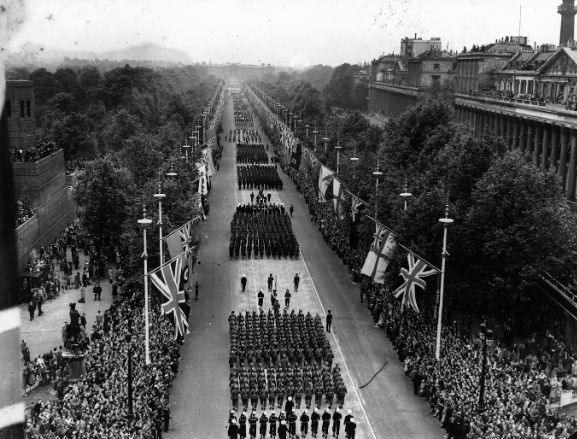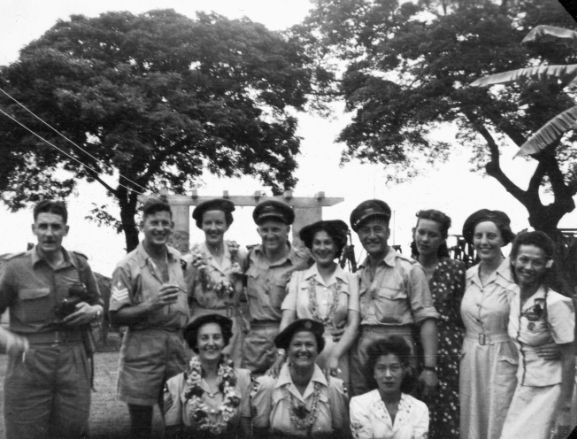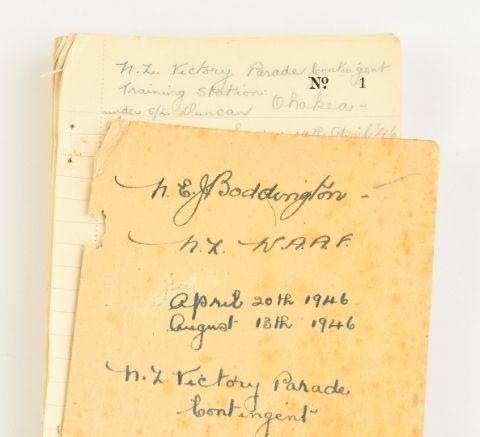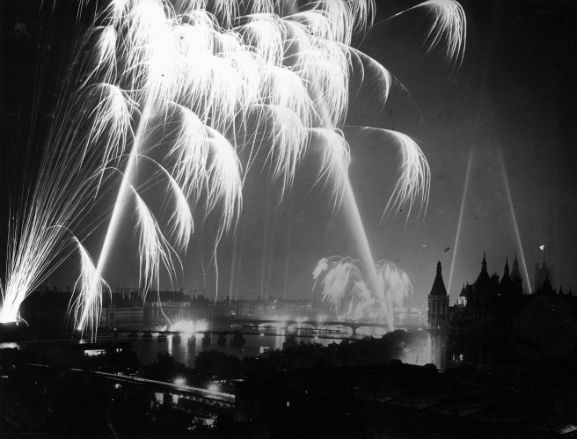75 years ago, the troopship “SS Maunganui” left Wellington to convey the New Zealand Victory contingent to the United Kingdom. Embarking on 20 April 1946, this journey took them all the way to London, where they joined a total of 1,600 personnel representing Commonwealth forces in the victory parade on 8 June 1946.

Selection and Training
Personnel were selected from the Army, Navy and Air Force to represent New Zealand at the victory parade. According to the Minister of Defence Mr F. Jones, who announced their names on 12 April 1946, ‘Great care has been taken to ensure that all overseas service in all theatres of war counted in the selection.’ In making the selection preference was given to those who had distinguished or long service overseas. Only those physically fit were considered, because the contingent would have to march for several hours in the mid-summer heat of London.
All branches of the three services, including the New Zealand WAAF (Women’s Auxiliary Air Force), WRNS (Women’s Royal Naval Service), WAAC (Women’s Army Auxiliary Corps) and the New Zealand Nursing Corps were represented, and the quotas allotted were proportional to the numbers who had served in each branch. They also included men and women from ‘civvy street’, who had since left the services. The lucky names were published in the Gisborne Herald, which you can read here.
‘Everything had happened so suddenly’, remembered Warrant Officer (W) Catherine Frances Bryers (incorrectly listed as “Byrnes” in the papers). She was called into her supervisor’s office at Whenuapai only the day prior and told the news, that she was to be on the tarmac ready to fly to Ohakea by 900 hours the next day! In her account of their pre-departure, she writes:
‘I am sure my mouth must have fallen wide open in surprise, when she told me that my application for selection for the Victory Parade in London, had been approved. The parade was to take place on 8th June 1946, the date on which I had enlisted in the Womens [sic] Auxiliary Air Force in 1942, little knowing that it would be of such significance to me four years later.’

Matters weren’t helped by a nasty cold, but that couldn’t dim her excitement. One of her Accounts Section workmates, Ellen Ainscough, helped her pack:
‘Without Ellen’s help, I would have spent most of the night packing, although I was too excited to get much sleep. Ellen woke me early next morning, with a hot lemon drink which cleared my head considerably.’
As it turned out, the plane was not going to Ohakea after all, so Warrant Officer Bryers ended up catching the Wellington Express to Marton – a hectic start to a week’s training!
The WAAF contingent trained at Ohakea for the parade under the command of Flight Officer Nina E. Boddington and their training supervised by Squadron Leader James Edward Duncan, the ‘Bull’ – ‘…never having heard him in action before, soon knew why he had earned that nickname’. The daily routine for all personnel consisted of drill, marching and physical training as well as medical and dental exams, and visiting the Clothing Store to be fitted for uniforms, service gear eg. kit bags (the officers’ uniforms were always tailor-made). There were also regular route marches, as Warrant Officer Bryers recalls:
‘We used to go on route marches as part of our training to get used to the long distance we would have to march in London, either to Sanson or Bulls and back and although we felt stiff and sore the first time, it soon wore off.’

Journey to London
The liner SS Maunganui embarked from Wellington on 20 April 1946. Nearly 1,000 people gathered at the wharf to see them off on their journey. Their voyage via Panama took 37 days, during which inspections, route marches, physical training and rifle drill continued.
The RNZAF Official Historian for the voyage, Flight Sergeant Charles Arthur Choldcroft, noted tropical conditions were their greatest enemy regarding the health and wellbeing of the contingent, and strangely, the ‘Care of feet: It is advised that the feet of all ranks will be inspected on Tuesdays and Thursdays of each week.’ Sounds odd enough, but the amount of marching required of the contingent was such that they needed to be in operational order!
The ship landed in England at Port Tilbury on 27 May 1946. While anchored off Southend-on-Sea the day before, the contingent performed a haka on “A” Deck, followed by community singing by all personnel, both led by Lieutenant Colonel Awatere. Flight Sergeant Choldcroft writes:
‘The vibrating roars and the thundering of hundreds of feet as the Haka was in full swing tortured the stillness of the night while Old Father Thames lapped lazily along Maunganui plates.’

Preparations in London
On arrival in London, preparations continued for the big day, when representatives from the British Commonwealth, Empire and Allied countries would celebrate the Allied victory with a military parade through the city and evening fireworks display.
The men of the New Zealand contingent were camped in bell tents at the Dominions Camp in Kensington Gardens, while the women’s services camped at Bushy Park, quartered in huts. According to Flight Officer Nina Boddington:
‘When all Contingents had arrived – including the English A.T.S. – W.A.A.F. & their officers, there were 200 officers & 1400 other ranks. Training did not commence until Mon- 3rd June when we all went into Kensington Gardens and commenced training under the instruction of an Irish Guards Sgt Major. We were always free in the afternoons & evenings. We always had lunch at the Fernleaf Club and then proceeded in various directions sightseeing.’
She recalled there was to be a final rehearsal with a band, but their transport did not arrive at Bushy Park on time, so they missed the rehearsal and had no further practice for the three days prior to the event, ‘except with all our walking about London & up & down escalators steps in the underground we were fit enough for our long march.’

Parade Day
On 8 June 1946 the day had arrived. Flight Officer Boddington recalls the early morning:
‘At 0800 hrs our troop carriers were waiting for us. The 1600 personnel all travelled in together in one convoy – to our parade ground in Hyde Park where we were met by a Guards Officer who marched us to our parade ground where we were later joined by the men of the Contingent.‘
First came the Chiefs of Staff’s procession, including the Supreme Allied Commanders, followed by a column of over 500 British military and civilian vehicles from Regent’s Park to Tower Hill to the Mall, and back to Regent’s Park.
Next, a marching column, starting at Marble Arch to the Mall to Hyde Park Corner. Headed by the flags of the Allies taking part in the parade, each with an honour guard. Then the units of the navies, air forces, civilian services and units of the British Empire, and the armed forces of the Commonwealth Dominions.
The New Zealand services were led by the Navy, followed by the Army and the Air Force. Wing Commander Barry Nicholl (also the Wigram CO) led the RNZAF section of the Victory contingent. In turn, they were followed by units from the British military and civilian services, and finally, a grand fly-past of RAF aircraft, led by Group Captain Sir Douglas Bader. The impressive line-up included: Hurricanes, Sunderlands, Lancasters, Mosquitos, Sea Mosquitos, Beaufighters, Firebrands, Seafires, Spitfires, Fireflies, Tempests, Meteors and Vampires.






